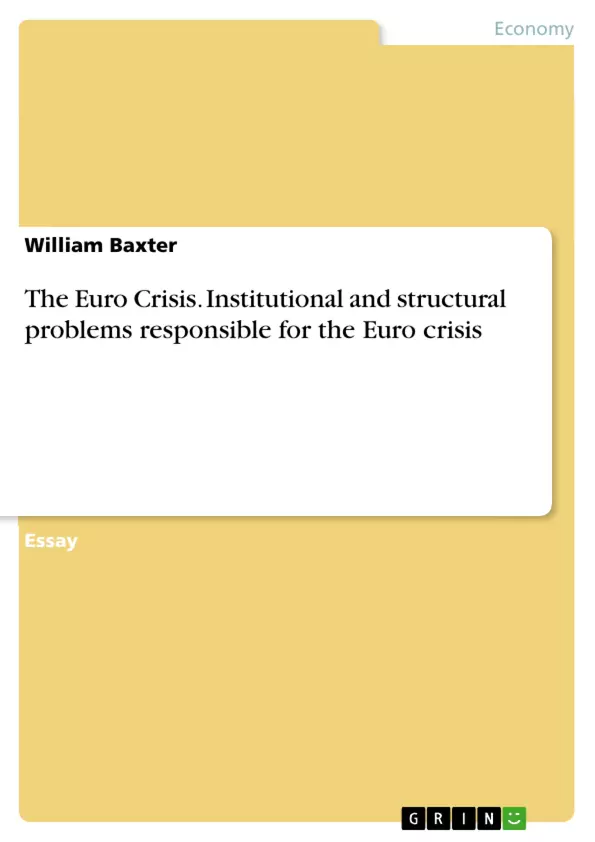Although catalysed by the Global Financial Crisis (GFC) of 2007-2008, substantial responsibility for the Euro crisis can be attributed to the institutional and structural problems entrenched in the design of the European Economic and Monetary Union (EMU). The crisis led to subdued growth and record levels of unemployment in the economies of Greece, Ireland, Italy, Portugal and Spain – collectively known as the GIIPS – and the wider eurozone. The beginnings of the crisis were in the sovereign debt problems of these countries, the causes of which varied from successive unsustainable government deficits in Greece, to bank guarantees and bailouts shifting private debt into public hands in Ireland and Spain. What these sovereign debt crises had in common, however, were the structural and institutional problems of the EMU, which both created the conditions for, and prevented the recovery of, the wider Euro crisis.
This essay will outline these problems. First, institutions and structures in the political economy will be briefly defined. Secondly, the inability of a united monetary policy to cater for the differences between northern and southern European varieties of capitalism will be examined. Thirdly, the structures and institutions hindering a swift and effective economic recovery will be outlined. Finally, the viability of proposed recovery approaches will be evaluated.
Inhaltsverzeichnis (Table of Contents)
- I INTRODUCTION
- II STRUCTURES AND INSTITUTIONS
- III VARIETIES OF CAPITALISM
- A Northern European Economies
- B Southern European Economies
- IV PROBLEMS HINDERING ECONOMIC RECOVERY
- A Fiscal Unity
- B Identity and Solidarity
Zielsetzung und Themenschwerpunkte (Objectives and Key Themes)
This essay analyzes the institutional and structural problems that contributed to the Euro crisis. The author examines the Eurozone's inability to address the differing economic models of northern and southern European countries, highlighting the resulting challenges for monetary policy. The essay then delves into the structural and institutional deficiencies that hindered the Eurozone's recovery from the crisis, including the lack of fiscal unity and the impact of low levels of pan-European identity and solidarity.
- The role of institutions and structures in the Euro crisis
- The impact of divergent economic models in northern and southern Europe
- The limitations of a unified monetary policy for diverse economies
- Structural and institutional barriers to economic recovery
- The political and economic implications of the Euro crisis
Zusammenfassung der Kapitel (Chapter Summaries)
The Introduction sets the stage by outlining the substantial responsibility of the Eurozone's institutional and structural problems in the Euro crisis, which manifested in the sovereign debt problems of the GIIPS. The essay then defines key terms related to institutions and structures in the political economy, establishing a framework for the subsequent analysis.
Chapter III examines the challenges posed by the distinct economic models of northern and southern European countries. The author explains how the export-driven economies of the north rely on a cautious monetary policy that is not conducive to the growth strategies of demand-led southern European economies. This disparity highlights the inherent tensions within the Eurozone, leading to difficulties in managing inflation and debt.
Chapter IV explores the structural deficiencies that hindered the Eurozone's economic recovery. The lack of fiscal unity, characterized by the absence of automatic transfer payments, is identified as a major obstacle. Additionally, the author emphasizes the impact of low levels of pan-European identity and solidarity, which make non-automatic fiscal transfers politically challenging.
Schlüsselwörter (Keywords)
The Euro crisis, European Economic and Monetary Union (EMU), institutional and structural problems, varieties of capitalism, northern and southern European economies, fiscal unity, pan-European identity and solidarity, economic recovery, monetary policy, austerity, debt, inflation.
- Quote paper
- William Baxter (Author), 2018, The Euro Crisis. Institutional and structural problems responsible for the Euro crisis, Munich, GRIN Verlag, https://www.grin.com/document/462261



